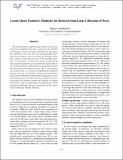Files in this item
Learnt quasi-transitive similarity for retrieval from large collections of faces
Item metadata
| dc.contributor.author | Arandelovic, Ognjen | |
| dc.date.accessioned | 2016-09-16T15:30:11Z | |
| dc.date.available | 2016-09-16T15:30:11Z | |
| dc.date.issued | 2016-06-26 | |
| dc.identifier | 245211630 | |
| dc.identifier | b4ac1e0e-ba61-4cfb-822e-d6b9536b6a76 | |
| dc.identifier | 84986286603 | |
| dc.identifier | 000400012304102 | |
| dc.identifier.citation | Arandelovic , O 2016 , Learnt quasi-transitive similarity for retrieval from large collections of faces . in Proceedings of the 2016 IEEE Conference on Computer Vision and Pattern Recognition (CVPR) . , 7780897 , IEEE Computer Society Conference on Computer Vision and Pattern Recognition , IEEE Computer Society , pp. 4883-4892 , IEEE Conference on Computer Vision and Pattern Recognition , Las Vegas , United States , 26/06/16 . https://doi.org/10.1109/CVPR.2016.528 | en |
| dc.identifier.citation | conference | en |
| dc.identifier.isbn | 9781467388511 | |
| dc.identifier.issn | 1063-6919 | |
| dc.identifier.uri | https://hdl.handle.net/10023/9516 | |
| dc.description.abstract | We are interested in identity-based retrieval of face sets from large unlabelled collections acquired in uncontrolled environments. Given a baseline algorithm for measuring the similarity of two face sets, the meta-algorithm introduced in this paper seeks to leverage the structure of the data corpus to make the best use of the available baseline. In particular, we show how partial transitivity of inter-personal similarity can be exploited to improve the retrieval of particularly challenging sets which poorly match the query under the baseline measure. We: (i) describe the use of proxy sets as a means of computing the similarity between two sets, (ii) introduce transitivity meta-features based on the similarity of salient modes of appearance variation between sets, (iii) show how quasi-transitivity can be learnt from such features without any labelling or manual intervention, and (iv) demonstrate the effectiveness of the proposed methodology through experiments on the notoriously challenging YouTube database. | |
| dc.format.extent | 10 | |
| dc.format.extent | 1666888 | |
| dc.language.iso | eng | |
| dc.publisher | IEEE Computer Society | |
| dc.relation.ispartof | Proceedings of the 2016 IEEE Conference on Computer Vision and Pattern Recognition (CVPR) | en |
| dc.relation.ispartofseries | IEEE Computer Society Conference on Computer Vision and Pattern Recognition | en |
| dc.subject | QA75 Electronic computers. Computer science | en |
| dc.subject | NDAS | en |
| dc.subject | BDC | en |
| dc.subject | R2C | en |
| dc.subject | ~DC~ | en |
| dc.subject.lcc | QA75 | en |
| dc.title | Learnt quasi-transitive similarity for retrieval from large collections of faces | en |
| dc.type | Conference item | en |
| dc.contributor.institution | University of St Andrews. School of Computer Science | en |
| dc.identifier.doi | https://doi.org/10.1109/CVPR.2016.528 | |
| dc.identifier.url | http://www.cv-foundation.org/openaccess/content_cvpr_2016/papers/Arandjelovic_Learnt_Quasi-Transitive_Similarity_CVPR_2016_paper.pdf | en |
This item appears in the following Collection(s)
Items in the St Andrews Research Repository are protected by copyright, with all rights reserved, unless otherwise indicated.

